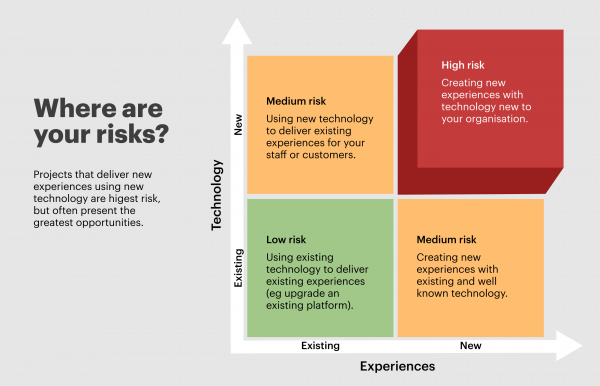Watene Hema: Scholarship ignites drive and purpose
Find out why Watene Hema came away from the Risk Assessment course with a greater understanding of what risk really means.

Right now, large digital projects are more expensive and riskier than ever. This is because client demand for technology services is very high and supply is low.
On top of that, demand for individuals with technology skills far outstrips the supply of talent from industry or education institutes.
And on top of that, we have constricted labour movement owing to covid-19. It all adds up to a talent crisis that is making it harder for non-digital companies to get good results from digital projects.
Of course, this talent crisis is good news for designers and developers. Their salaries are rising rapidly as the large technology product companies compete with the banks, which compete with the large consultancies, which compete with the technology vendors, which compete with well-funded start ups.
Everyone is fighting over the same talent pool. This is further exacerbated in New Zealand by global companies that are now more comfortable employing remote talent, and paying higher wages.
This talent shortage is causing high turnover within the industry as people move from company to company for higher salaries. Unfortunately, turnover of key staff at critical times puts digital projects at significant risk.
Behind the scenes at many technology vendors, resources are constantly being scrambled as teams are chopped and changed between projects to try to meet client demands and cope with staffing volatility. Naturally, this results in inefficiencies, frustration and lost productivity. Projects quickly lose the love and momentum.
In response to all these factors, the technology companies that provide design and development services have had to put their prices up. They are also far less inclined to be lenient in contract negotiations, nor tolerate indecisive or dissatisfied clients. They have to bill every hour to cover the costs of their highly-paid staff. There is a now a signiciant imbalance of power and an unfair allocation of risk between client and vendor.
So what does this mean if you’re a director of an organisation that depends on technology vendors to deliver digital projects?
In short, it means that your organisation is likely to be paying more and getting less. It also means that mistakes will cost significantly more, and your organisation will be carrying most of the risk. So what can you do about it?
You can’t fix the situation with tougher contracts or more strenuous procurement processes. Your organisation has to be a better and smarter client. You have to get nearer to your vendors and collaborate more closely. If you’re a director, here are three areas you can focus on to help guide your digital projects and increase their chances of success.
No matter the size of the digital project, establish a clear vision for success at the outset and develop an agreed set of principles that will guide the project towards that vision. Make sure that the board thoroughly interrogates and understands what will make the project successful.
During a complex digital project, many people will be involved and others will come and go. Each person will have a different idea of what’s most important. This puts pressure on the project and can move it in different, costly and unintended directions. At critical junctures and decision-points, well-articulated principles become invaluable. They help with debate and guide decision-making.
For example, a digital project that I’ve been working on with a large Government agency for over two years has a clear vision and five guiding principles. One of which is ‘Any data is better than no data’. This principle has come to the fore during numerous debates about the quality of the data, how it’s collected, how secure it is and how it will be used.
Instead of the project being hijacked or thwarted in pursuit of data purity, the imperfections in the data are accepted and the project moves forward.
Does your organisation’s digital project have an agreed set of guiding principles? If so, are they understood, clearly articulated and referred to regularly? And as a director, do they make sense to you? Can you draw a line between the principles, the project, and your organisation’s overall strategy?
Even without the current demand pressures, there are many risks associated with large digital projects. These include a lack of clarity around purpose, poor communication of the strategy, insufficient resourcing, poor execution, staff turnover, erroneous design, poor technology choices, lack of testing, poor vendor fit….the list goes on. As always, the key is to know where the biggest risks lie.
A good place to start is to think about the type of project your organisation is undertaking. The riskiest projects involve the need to provide new experiences for your customers, using new technology or technology new to your organisation. If you were a health provider, an example might be developing a mobile app that lets patients log daily health information.
Conversely, the least risky projects involve existing experiences using established technology already familiar to your organisation. An example might be an upgrade to your website’s content management system. Naturally, the associated risks and how you oversee these projects are completely different.
The 2x2 matrix below helps you think about the different risk profiles of different projects. Projects should be assessed and managed differently based on where they fit in the matrix. As a director, you have to have at least a high-level understanding of how the intended experiences and technologies are expected to deliver business value, so that you can assess the different types of risks.

For the riskier projects, it’s vital that the new experiences and new technology components are frequently validated along the way. The worst thing you can do is continue a project without testing and checking that the design and technology will actually deliver the promised business results. To reduce risk you need many gates and off-ramps. However, for the least risky projects, it’s often the opposite. The worst thing you can do is stop a project before it’s completed and delivered some business value.
As a director, think about where your project lies on the matrix and consider the associated risks. The more ‘novel’ a project is to your organisation, the closer it needs to be governed — especially if the project is central to your organisation’s value proposition. If the project is core to what your organisation does, then the impacts and size of the risks quickly multiply.
For directors familiar with The Four Pillars of Governance Best Practice, this heading will resonate. The third of four pillars is ‘holding to account’.
If your organisation is undertaking a significant digital project, directors need to be directly involved. If you’re one of those directors, you need to get close to the action. You need to check in regularly so you know what’s going on and can effectively hold the project to account against the agreed vision and principles.
In significant and ‘novel’ digital projects, there is often a large degree of uncertainty, discovery and rethinking required. The gap between the intended strategy and the execution is very small. You can’t sit back and steer from afar because subtle changes can quickly push a project off course. You need to keep bringing the project team back to the vision.
In practical terms, holding to account might mean sitting on a digital project committee, attending vendor and product demonstrations, being an early tester of a new product, observing real customers testing the product, spending time with the staff and vendors working on the project etc. Basically, you want to get close enough to determine if your organisation really does have the right capability and capacity in place to deliver. You want to have confidence that the right design and technology choices have been made. You need to connect what you’re observing with how your organisation’s desired outcomes will be met.
Importantly, you cannot rely on vendors or management reports to tell you if the project is succeeding — you need to see it for yourself. You need first-hand evidence that the project is heading in the right direction. And wherever possible, use data to monitor progress.
In summary, if you have the right vision, principles and risk management in place, and you are close enough to the action to hold the project to account, your digital project should succeed. You will add huge value by reducing costs and risks.
Also by Tom Hovey: Is covid-19 driving your digital transformation?

Tom Hovey MInstD is a creative consultant with over 25 years of digital experience working in New Zealand and the United Kingdom. Tom helps organisations develop digital strategies that deliver meaningful results.
The views expressed in this article do not reflect the position of the IoD unless explicitly stated.
Contribute your perspectives and expertise on an area of governance to the IoD membership and governance community. Contact us mail@iod.org.nz